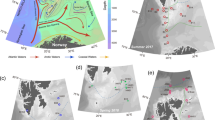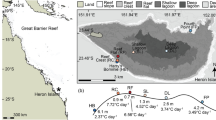Abstract
Irradiance and temperature variations during tidal cycles modulate microphytobenthic primary production potentially by changing the radiative energy balance of photosynthetic mats between immersion and emersion and thus sediment daily net metabolism. To test the effect of tidal stages on the radiative energy budget, we used microsensor measurements of oxygen, temperature, and scalar irradiance to estimate the radiative energy budget in a coastal photosynthetic microbial mat during immersion (constant water column of 2 cm) and emersion under increasing irradiance. Total absorbed light energy was higher in immersion than emersion, due to a lower reflectance of the microbial mat, while most (> 97%) of the absorbed light energy was dissipated as heat irrespective of tidal conditions. During immersion, the upward heat flux was higher than the downward one, whereas the opposite occurred during emersion. At highest photon irradiance (800 μmol photon m−2 s−1), the sediment temperature increased ~ 2.5 °C after changing the conditions from immersion to emersion. The radiative energy balance showed that less than 1% of the incident light energy (PAR, 400–700 nm) was conserved by photosynthesis under both tidal conditions. At low to moderate incident irradiances, the light use efficiency was similar during the tidal stages. In contrast, we found an ~ 30% reduction in the light use efficiency during emersion as compared to immersion under the highest irradiance likely due to the rapid warming of the sediment during emersion and increased non-photochemical quenching. These changes in the photosynthetic efficiency and radiative energy budget could affect both primary producers and temperature-dependent bacterial activity and consequently daily net metabolism rates having important ecological consequences.










Similar content being viewed by others
References
Underwood GJC, Kromkamp J (1999) Primary production by phytoplankton and microphytobenthos in estuaries. Adv Ecol Res 29:93–153
Huber C, Davoult D, Cariou T, Artigas LF (2006) Factors controlling benthic metabolism during low tide along a granulometric gradient in an intertidal bay (Roscoff Aber Bay, France). Mar Ecol Prog Ser 316:53–68
Consalvey M, Paterson DM, Underwood GJC (2004) The ups and downs of life in a benthic biofilm: migration of benthic diatoms. Diatom Res 19:181–202
Migné A, Spilmont N, Davoult D (2004) In situ measurements of benthic primary production during emersion: seasonal variations and annual production in the Bay of Somme (eastern English Channel, France). Cont Shelf Res 24:1437–1449
Pinckney JL, Zingmark R (1991) Effects of tidal stage and sun angles on intertidal benthic microalgal productivity. Mar Ecol Prog Ser 76:81–89
Serôdio J, Catarino F (2000) Modelling the primary productivity of intertidal microphytobenthos: time scales of variability and effects of migratory rhythms. Mar Ecol Prog Ser 192:13–30
Colijn F, Admiraal W, Baretta JW, Ruardij P (1987) Primary production in a turbid estuary, the Ems-Dollard: field and model studies. Cont Shelf Res 7:1405–1409
Kromkamp J, Peene J, van Rijswijk P, Sandee A, Goosen N (1995) Nutrients, light and primary production by phytoplankton and microphytobenthos in the eutrophic, turbid Westerschelde estuary (The Netherlands). Hydrobiologia 311:9–19
Spilmont N, Migné A, Seuront L, Davoult D (2007) Short-term variability of intertidal benthic community production during emersion and the implication in annual budget calculation. Mar Ecol Prog Ser 333:95–101
Denis L, Gevaert F, Spilmont N (2012) Microphytobenthic production estimated by in situ oxygen microprofiling: short-term dynamics and carbon budget implications. J Soils Sediments 12:1517–1529
Kwon B-O, Koh C-H, Khim JS, Park J, Kang S-G, Hwang JH (2014) The relationship between primary production of microphytobenthos and tidal cycle on the Hwaseong mudflat, west coast of Korea. J Coast Res 298:1188–1196
Cartaxana P, Cruz S, Gameiro C, Kuhl M (2016) Regulation of intertidal microphytobenthos photosynthesis over a diel emersion period is strongly affected by diatom migration patterns. Front Microbiol 7:1–11
Kromkamp J, Barranguet C, Peene J (1998) Determination of microphytobenthos PSII quantum efficiency and photosynthetic activity by means of variable chlorophyll fluorescence. Mar Ecol Prog Ser 162:45–55
Chennu A, Grinham A, Polerecky L, de Beer D, Al-Najjar MAA (2015) Rapid reactivation of cyanobacterial photosynthesis and migration upon rehydration of desiccated marine microbial mats. Front Microbiol 6:1–9
Serôdio J, Cruz S, Vieira S, Brotas V (2005) Non-photochemical quenching of chlorophyll fluorescence and operation of the xanthophyll cycle in estuarine microphytobenthos. J Exp Mar Biol Ecol 326:157–169
Falkowski PG, Raven JA (1997) Aquatic photosynthesis. Blackwell Sci doi: https://doi.org/10.1017/CBO9781107415324.004
Kuhl M, Lassen C, Revsbech NP (1997) A simple light meter for measurements of PAR (400 to 700 nm) with fiber-optic microprobes: application for P vs E0(PAR) measurements in a microbial mat. Aquat Microb Ecol 13:197–207
Kuhl M, Glud RN, Ploug H, Ramsing NB (1996) Microenvironmental control of photosynthesis and photosynthesis-coupled respiration in an epilithic cyanobacterial biofilm. J Phycol 32:799–812
Kuhl M, Lassen C, Jorgensen BB (1994) Light penetration and light intensity in sandy marine sediments measured with irradiance and scalar irradiance fiber-optic microprobes. Mar Ecol Prog Ser 105:139–148
Lassen C, Ploug H, Jorgensen BB (1992) Microalgal photosynthesis and spectral scalar irradiance in coastal marine sediments of Limfjorden, Denmark. Limnol Oceanogr 37:760–772
Jørgensen BB, Revsbech NP (1985) Diffusive boundary layers and the oxygen uptake of sediments and detritus. Limnol Oceanogr 30:111–122
Glud RN (1994) Effects on the benthic diffuse boundary layer imposed by microelectrodes. Limnol Oceanogr 39:462–467
Li T, Podola B, de Beer D, Melkonian M (2015) A method to determine photosynthetic activity from oxygen microsensor data in biofilms subjected to evaporation. J Microbiol Methods 117:100–107
Lara M, Bohorquez J, Jiménez-arias JL, Crespo JM, Papaspyrou S, Garcia-Robledo E, Meysman F (2018) Microscale drivers of oxygen dynamics during emersion: microphytobenthic production, sediment compaction and shifts on diffusivity. Eur. Geosci. Union Gen. Assem. Geophys. Res. Abstr. Vol. 20, EGU2018-19488
Coelho H, Vieira S, Serôdio J (2009) Effects of desiccation on the photosynthetic activity of intertidal microphytobenthos biofilms as studied by optical methods. J Exp Mar Biol Ecol 381:98–104
Jimenez IM, Kuhl M, Larkum AWD, Ralph PJ (2008) Heat budget and thermal microenvironment of shallow-water corals: do massive corals get warmer than branching corals? Limnol Oceanogr 53:1548–1561
Harrison SJ, Phizacklea AP (1987) Vertical temperature gradients in muddy intertidal sediments in the forth estuary, Scotland1. Limnol Oceanogr 32:954–963
Serôdio J, Catarino F (1999) Forthnightly light and temperature variablility in estuarine intertidal sediments and implications for microphytobenthos primary productivity. Aquat Ecol 33:235–241
Blanchard GF, Guarini J-M, Richard P, Gros P, Mornet F (1996) Quantifying the short-term temperature effect on light-saturated photosynthesis of intertidal microphytobenthos. Mar Ecol Prog Ser 134:309–313
Vieira S, Richard J, Marques da Silva J, Cartaxana P (2013) Effects of short-term changes in sediment temperature on the photosynthesis of two intertidal microphytobenthos communities. Estuar Coast Shelf Sci 119:112–118
Al-Najjar MAA, de Beer D, Kuhl M, Polerecky L (2012) Light utilization efficiency in photosynthetic microbial mats. Environ Microbiol 14:982–992
Lichtenberg M, Brodersen KE, Kuhl M (2017) Radiative energy budgets of phototrophic surface-associated microbial communities and their photosynthetic efficiency under diffuse and collimated light. Front Microbiol 8:1–8
Al-Najjar MAA, de Beer D, Jørgensen BB, Kuhl M, Polerecky L, De Beer D (2010) Conversion and conservation of light energy in a photosynthetic microbial mat ecosystem. ISME J 4:440–449
Nielsen M, Revsbech NP, Kuhl M (2015) Microsensor measurements of hydrogen gas dynamics in cyanobacterial microbial mats. Front Microbiol 6. https://doi.org/10.3389/fmicb.2015.00726
Kuhl M, Jorgensen BB (1994) The light field of microbenthic communities: radiance distribution and microscale optics of sandy coastal sediments. Limnol Oceanogr 39:1368–1398
Ploug H, Lassen C, Jørgensen BB (1993) Action spectra of microalgal photosynthesis and depth distribution of spectral scalar irradiance in a coastal marine sediment of Limfjorden, Denmark. FEMS Microbiol Lett 102:261–270
Rickelt LF, Lichtenberg M, Trampe E, Løvbjerg C, Kuhl M (2016) Fiber-optic probes for small-scale measurements of scalar irradiance. Photochem Photobiol 92:331–342
Revsbech NP, Jorgensen BB (1983) Photosynthesis of benthic microflora measured with high spatial resolution by the oxygen microprofile method: capabilities and limitations of the method. Limnol Oceanogr 28:749–756
Jorgensen BB, Cohen Y, Des Marais DJ (1987) Photosynthetic action spectra and adaptation to spectral light distribution in a benthic cyanobacterial mat. Appl Environ Microbiol 53:879–886
Kuhl M (2005) Optical microsensors for analysis of microbial communities. Methods Enzymol 397:166–199
Kazemipour F, Méléder V, Launeau P (2011) Optical properties of microphytobenthic biofilms (MPBOM): biomass retrieval implication. J Quant Spectrosc Radiat Transf 112:131–142
Launeau P, Méléder V, Verpoorter C, Barillé L, Kazemipour F, Giraud M, Jesus B, Le Menn E (2018) Microphytobenthos biomass and diversity mapping at different spatial scales with a hyperspectral optical model. Remote Sens. https://doi.org/10.3390/rs10050716
Young H, Freedman R, Ford L (1996) University physics, with modern physics
Balandin AA, Ghosh S, Bao W, Calizo I, Teweldebrhan D, Miao F, Lau CN (2008) Superior thermal conductivity of single-layer graphene. Nano Lett 8:902–907
Brodersen KE, Lichtenberg M, Ralph PJ, Kuhl M, Wangpraseurt D (2014) Radiative energy budget reveals high photosynthetic efficiency in symbiont-bearing corals. J R Soc Interface 11:20130997
Webb WL, Newton M, Starr D (1974) Carbon dioxide exchange of Alnus rubra. Oecologia 17:281–291
Lara M, Bohorquez J, Jiménez-Arias JL, Haro S, Crespo JM, Papaspyrou S, Garcia-Robledo E, Meysman F, Revsbech NP, Corzo A Non-steady state oxygen levels in air-exposed intertidal sediments: sediment surface contraction, diffusivity changes and microalgal movements
Serôdio J, Silva JM, Catarino F (1997) Nondestructive tracing of migratory rhythms of intertidal benthic microalgae using in vivo chlorophyll a fluorescence. J Phycol 33:542–553
Yallop ML, de Winder B, Paterson DM, Stal LJ (1994) Comparative structure, primary production and biogenic stabilization of cohesive and non-cohesive marine sediments inhabited by microphytobenthos. Estuar Coast Shelf Sci 39:565–582
Kuhl M, Fenchel T (2000) Bio-optical characteristics and the vertical distribution of photosynthetic pigments and photosynthesis in an artificial cyanobacterial mat. Microb Ecol 40:94–103
Binzer T, Sand-Jensen K, Middelboe AL (2006) Community photosynthesis of aquatic macrophytes. Limnol Oceanogr 51:2722–2733
Krause-Jensen D, Sand-Jensen K (1998) Light attenuation and photosynthesis of aquatic plant communities. Limnol Oceanogr 43:396–407
Binzer T, Sand-Jensen K (2002) Production in aquatic macrophyte communities: a theoretical and empirical study of the influence of spatial light distribution. Limnol Oceanogr 47:1742–1750
Garcia-Pichel F, Mechling M, Castenholz RW (1994) Diel migrations of microorganisms within a benthic, hypersaline mat community. Appl Environ Microbiol 60:1500–1511
Cartaxana P, Ruivo M, Huber C, Davidson I, Serôdio J, Jesus B (2011) Physiological versus behavioral photoprotection in intertidal epipelic and epipsammic benthic diatom communities. J Exp Mar Biol Ecol 405:120–127
Thar R, Kuhl M, Holst G (2001) Fiber-optic fluorometer for microscale mapping of photosynthetic pigments in microbial communities. Appl Environ Microbiol 67:2823–2828
Hancke K, Glud RN (2004) Temperature effects on respiration and photosynthesis in three diatom-dominated benthic communities. Aquat Microb Ecol 37:265–281
Guarini J-M, Blanchard GF, Gros P, Harrison SJ (1997) Modelling the mud surface temperature on intertidal flats to investigate the spatio-temporal dynamics of the benthic microalgal photosynthetic capacity. Mar Ecol Prog Ser 153:25–36
Faber PA, Kessler AJ, Bull JK, McKelvie ID, Meysman F, Cook PLM (2012) The role of alkalinity generation in controlling the fluxes of CO2 during exposure and inundation on tidal flats. Biogeosciences 9:4087–4097
Acknowledgements
This research is the result of a collaboration between the Microenvironmental Ecology Group (University of Copenhagen, Denmark) and Microbial Ecology and Biogeochemistry Laboratory (University of Cádiz, Spain) and was funded by CTM2013-43857-R and CTM2017-82274-R (MINECO, Spain) to AC, FPI grant to SH (PU-2014-043-FPI, Univ. Cadiz, Spain), a Sapere-Aude Advanced Grant to MK (DFF-1323-00065B, Independent Research Fund Denmark - Natural Sciences), and a postdoctoral fellowship from the Carlsberg Foundation to KEB.
Author information
Authors and Affiliations
Corresponding author
Electronic Supplementary Material
ESM 1
(DOCX 554 kb)
Rights and permissions
About this article
Cite this article
Haro, S., Brodersen, K.E., Bohórquez, J. et al. Radiative Energy Budgets in a Microbial Mat Under Different Irradiance and Tidal Conditions. Microb Ecol 77, 852–865 (2019). https://doi.org/10.1007/s00248-019-01350-6
Received:
Accepted:
Published:
Issue Date:
DOI: https://doi.org/10.1007/s00248-019-01350-6




